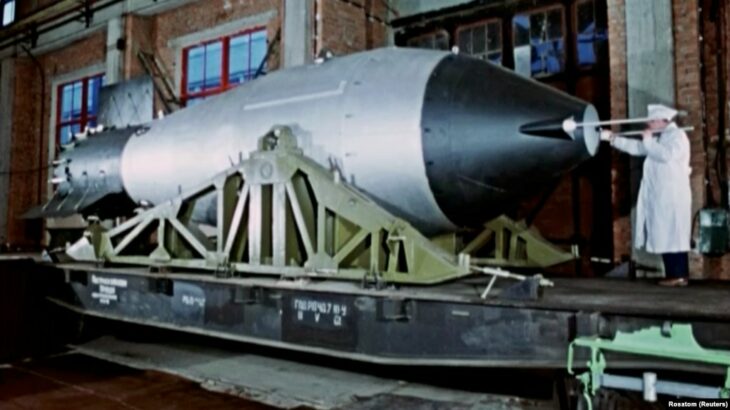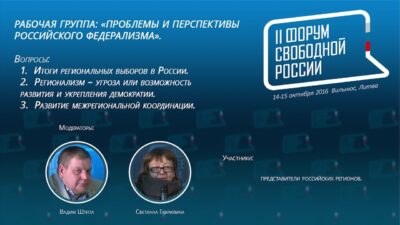
For most of the world, Andrei Sakharov, who was born 100 years ago this week, is remembered as a fearless and tireless champion of human rights and freedoms in the Soviet Union.
It was for his work as an outspoken dissident to the Soviet authorities that he was awarded the Nobel Peace Prize in 1975.
The citation called him “the conscience of mankind,” saying that he “has fought not only against the abuse of power and violations of human dignity in all its forms, but has in equal vigor fought for the ideal of a state founded on the principle of justice for all.”
But Sakharov was by training and vocation a nuclear physicist. He was an integral part of the Soviet nuclear weapons program and is even called the “father of the Soviet hydrogen bomb.”
In his memoirs, Sakharov recounted first hearing of nuclear fission just before the war from his father, himself a physics teacher, who had attended a lecture on the subject. But he said his interest was truly sparked when he heard of the atomic bombing of Hiroshima on August 6, 1945:
“On my way to the bakery, I stopped to glance at a newspaper and discovered President Truman’s announcement…. I was so stunned that my knees practically buckled. There could be no doubt that my fate and the fate of many others, perhaps of the entire world, had changed overnight. Something new and terrible had entered our lives, a product of the greatest of the sciences, of the discipline I revered.”
Sakharov And His ‘Layer Cake’
Sakharov was himself recruited to work on the Soviet nuclear weapons program in June 1948 by his professor, Igor Tamm. Later he wrote: “No one asked whether or not I wanted to take part in such work. I had no real choice in the matter, but the concentration, total absorption, and energy that I brought to the task were my own.”
A few months later, the young physics graduate student developed a totally new idea for an H-bomb design, one that he would call the sloika, or layer cake. The breakthrough would allow the Soviet Union to build its first hydrogen bomb, a device much more powerful that the atomic weapons of only a few years before.
Patriotism pushed Sakharov in this pursuit, explained Frank von Hippel, a senior research physicist and professor at Princeton University.
“Sakharov was convinced that the Soviet Union needed a nuclear deterrent against U.S. nuclear attack,” von Hippel explained in e-mailed remarks to RFE/RL.
On August 29, 1949, the Soviets had tested their first nuclear device — known as “Joe-1” in the West — on the remote steppes on what is now Kazakhstan. Ultimately, the Soviets would test 80 bombs, 36 in 1958 alone.
‘We Will Bury You’
With the Cold War with the United States heating up, Soviet leader Nikita Khrushchev turned to Sakharov to come up with the world’s most powerful bomb ever. This would become known in the West as the Tsar Bomba, the Tsar’s Bomb.
“The motivation for the Tsar Bomba test is best understood in the context of the U.S.-Soviet rivalry at the time. In the late 1950s and early 1960s, nuclear tests were used for research and as a demonstration of national power and strength,” explained Philip Coyle, the former head of U.S. nuclear weapons testing under U.S. President Bill Clinton, who worked 30 years helping design and test nuclear weapons.
“Soviet Premier Nikita Khrushchev’s visits to the United Nations in 1959 and 1960 — and his remark roughly translated at the time, ‘We will bury you’ — was seen by some in America as a nuclear threat. The U.S. had detonated a hydrogen bomb at the Bikini Atoll on March 1, 1954, that resulted in the largest yield of all American tests — 15 megatons. Tsar Bomba was nearly four times more destructive,” Coyle said in e-mailed comments to RFE/RL.
A Bomb Like No Other
Although remembered as Tsar Bomba, the explosive device was known under numerous technical names: Project 27000, Product Code 202, RDS-220, and Kuzinka Mat (Kuzka’s Mother). Its dimensions were off the charts. In length, it stretched some 8 meters. In height, it reached 2 meters. It weighed a ton as well: 24.5 tons, to be exact.
Tupolev Tu-95 bombers, the largest in the Soviet fleet, were too small to carry it. One bomber had to be reconfigured, its fuel tanks and bomb-bay doors removed. Tsar Bomba still couldn’t fit inside and had to be carried under the aircraft.
Tsar Bomba posed other challenges, as well. To give the pilot of the bomber a chance of surviving — calculated by the Soviets as no more than a 50 percent probability — a special parachute weighing nearly a ton was attached to the mega bomb to slow its decent. That extra time, the thinking went, would give the bomber and another plane monitoring and filming the explosion enough time to avoid the worst of the blast.
The Blast Felt Round The World
On the morning of October 30, 1961, the Tupolev lifted into the sky with its powerful payload from the Olenya airfield in the Kola Peninsula in the Far North of Russia. Its destination was even farther north, into the Arctic hinterlands of the Soviet Union.
The bomber dropped Tsar Bomba off the coast of Severny Island, the northern island of the sparsely populated Novaya Zemlya archipelago in the Barents Sea. It exploded 4,000 meters above the ground. The Tu-95 got caught in the shock wave, even though it was more than 100 kilometers away by the time of detonation. The plane plunged about 1,000 meters before the pilot regained control and ultimately landed safely.
The explosion was more than 1,570 times more powerful than the combined two bombs dropped on Hiroshima and Nagasaki and 10 times more powerful than all of the munitions used in World War II. The blast was visible from more than 1,000 kilometers away. The mushroom cloud climbed 70 kilometers into the air. People as far away as Finland and Norway reported feeling the blast, which shattered windows.
The destruction on Novaya Zemlya was devastating. All the houses in the village of Severny, some 55 kilometers from ground zero, were turned to rubble.
One Soviet cameraman who witnessed the detonation described what he saw:
“The clouds beneath the aircraft and in the distance were lit up by the powerful flash. The sea of light spread under the hatch and even clouds began to glow and became transparent. At that moment, our aircraft emerged from between two cloud layers and down below in the gap a huge bright orange ball was emerging. The ball was powerful and arrogant like Jupiter. Slowly and silently it crept upwards…. Having broken through the thick layer of clouds, it kept growing. It seemed to suck the whole Earth into it. The spectacle was fantastic, unreal, supernatural.”
Such a huge detonation was naturally difficult to hide or deny. A U.S. intelligence plane was in the vicinity at the time of the blast. Code-named Speedlight, the aircraft carried equipment to calculate the yield of distant nuclear explosions. That data would later be analyzed back in Washington.
But for decades, much remained unknown about Tsar Bomba. Last year, Russia declassified 40 minutes of previously unseen footage of the Tsar Bomba test and posted it on YouTube.




